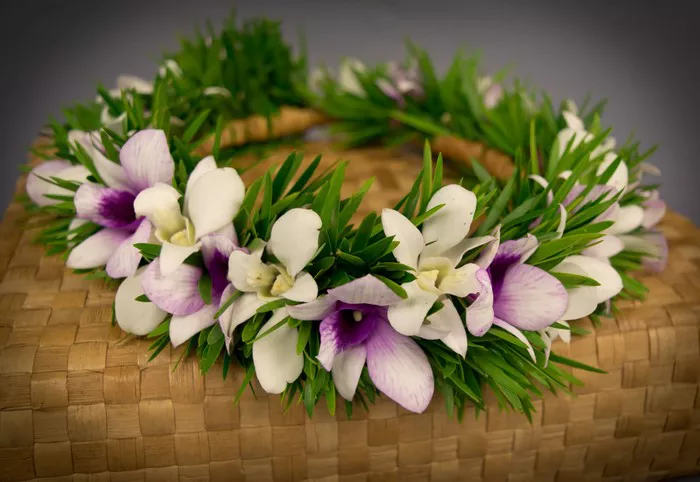Hawaiian leis are much more than just a floral necklace. They are rich symbols of the island’s culture, history, and spirit of aloha. Worn during celebrations, ceremonies, and as a gesture of welcome or farewell, leis encapsulate the beauty and diversity of Hawaiian flora. Understanding the types of flowers used in these leis provides a deeper appreciation of their significance and the artistry involved in their creation.
The Symbolism of Leis
Leis are symbolic in many ways. They represent love, friendship, celebration, and honor. Traditionally, leis were made of native flowers and plants, each carrying its own meaning and purpose. For example, a lei made from the fragrant maile vine is often associated with respect and honor, while plumeria leis symbolize positivity and new beginnings. The selection of flowers is not just about aesthetic appeal but also about the cultural and personal messages conveyed.
The Diversity of Flowers in Hawaiian Leis
1. Plumeria (Frangipani)
Plumeria flowers are among the most popular and iconic flowers used in Hawaiian leis. Known for their vibrant colors and delightful fragrance, plumerias come in various shades of white, yellow, pink, and red. These flowers are easy to work with, making them a favorite for lei makers. Plumeria leis are often associated with positive energy, grace, and new beginnings.
2. Orchids
Orchids are another favorite in lei making due to their exotic beauty and durability. Dendrobium orchids, in particular, are commonly used because they can withstand being strung together without wilting quickly. The colors range from pure white to deep purple, and their long-lasting nature makes them ideal for leis that need to stay fresh throughout an event. Orchid leis are often used for special occasions such as graduations and weddings.
3. Pikake (Jasmine)
Pikake flowers, also known as Arabian jasmine, are cherished for their intoxicating fragrance. These small, white flowers are delicate and symbolize love and romance. Pikake leis are often used in weddings and other intimate celebrations. The name “pikake” is the Hawaiian word for peacock, reflecting the flower’s introduction to Hawaii alongside the beautiful birds.
4. Maile Vine
Unlike the other flowers on this list, the maile vine is a leafy vine with a subtle, sweet scent. It is one of the oldest and most revered lei materials in Hawaiian culture. Maile leis are typically open-ended and draped over the shoulders. They are used in significant ceremonies and events such as graduations, weddings, and cultural celebrations. Maile represents respect, honor, and the spirit of aloha.
5. Hibiscus
The hibiscus flower is Hawaii’s state flower and a popular choice for leis. With its large, vibrant blooms, the hibiscus adds a dramatic flair to any lei. These flowers come in a variety of colors, each with its own significance. For example, red hibiscus represents love and passion, while yellow symbolizes friendship. Hibiscus leis are often used in festivals and public celebrations.
6. Tuberose
Tuberose flowers are known for their strong, sweet fragrance, which intensifies at night. These white, waxy flowers are often used in leis for special occasions, including weddings and anniversaries. Tuberose leis are valued for their aromatic qualities and their ability to evoke a sense of luxury and elegance.
7. Gardenia
Gardenias are highly prized for their rich, sweet fragrance and creamy white petals. These flowers are often used in leis for special occasions due to their delicate nature and beautiful scent. Gardenia leis symbolize purity and sweetness, making them ideal for weddings and romantic events.
8. Ilima
Ilima flowers are small, yellow-orange blooms that are native to Hawaii. These flowers were once reserved for Hawaiian royalty due to their rarity and the labor-intensive process of making leis from them. Ilima leis are associated with love and respect and are often used in traditional ceremonies.
9. Kukui Blossoms
The kukui tree is the state tree of Hawaii, and its blossoms are sometimes used in leis. The small, white flowers are not as commonly used as other lei flowers, but they hold cultural significance. Kukui leis can symbolize enlightenment and protection.
SEE ALSO: What Flowers Do They Use For Leis
The Craft of Lei Making
1. The Artistry and Technique
Lei making is an art form that requires skill, patience, and a deep understanding of the materials. Traditional lei making techniques include the kui method (sewing), haku (braiding), hili (twisting), and hipu’u (knotted). Each method produces a different style of lei, and the choice of technique often depends on the type of flowers and the occasion.
2. Cultural Significance
Leis are more than just decorative items; they are an integral part of Hawaiian culture. The process of making a lei is a meditative and spiritual practice, often involving chanting and prayers. Giving a lei is an act of love and respect, and receiving one is considered a blessing. The customs surrounding leis are deeply rooted in Hawaiian history and tradition.
3. Modern Adaptations
While traditional flowers and techniques remain popular, modern lei makers also experiment with new materials and designs. Silk flowers, ribbons, and other synthetic materials are sometimes used to create leis that last longer and are more affordable. These modern adaptations allow the tradition of lei giving to continue in new and innovative ways.
Conclusion
Hawaiian leis are a beautiful and meaningful expression of the island’s rich culture and natural beauty. The flowers used in leis each bring their unique qualities, adding layers of symbolism and significance to the tradition. From the fragrant plumeria and delicate pikake to the revered maile vine, each flower tells a story and contributes to the lei’s overall message of aloha. Whether used in celebration, ceremony, or as a gesture of friendship, leis remain a cherished part of Hawaiian life, embodying the spirit and beauty of the islands.


